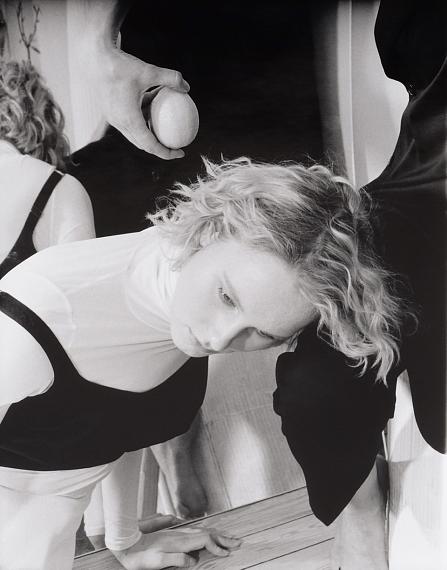
Untitled (Lemon, Mirror), 2019
Silver gelatin print
56 x 43 cm
3 + 2 AP
© Jenna Westra
Courtesy: SCHWARZ CONTEMPORARY
Jenna Westra »
Mellow Drama
Exhibition: 25 Jun – 31 Jul 2021
Thu 22 Jul

SCHWARZ CONTEMPORARY
Sanderstr. 28
12047 Berlin
+49 (30)-612 89 902
mail@schwarz-contemporary.com
www.schwarz-contemporary.com
Wed-Fri 12-18, Sat 12-16
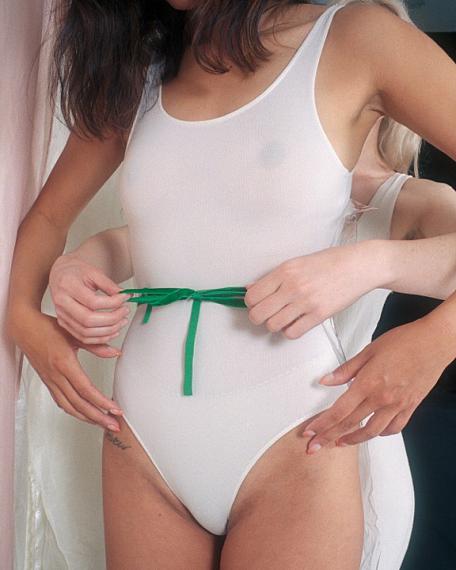
Ribbon Tie, 2021
C-print
66 x 53 cm
3 + 2 AP
© Jenna Westra
Courtesy: SCHWARZ CONTEMPORARY
Jenna Westra
"Mellow Drama"
Exhibition: 25 June – 31 July, 2021
Opening: Thursday, 24 June, 4-8pm
Jenna Westra’s photographs capture a performed intimacy — an ease of movement found in real life, duplicated in the studio. In Intertwined Women, I’m unsure where one body ends and the other begins. The feeling of a hand resting on my thigh is transferred through the image — the gesture is so familiar I can imagine the exact weight of the hand pushing down on me. Is it my own hand? Or a friend's? The distinction is inconsequential; the two forms of touch so closely resemble one another.
The overlapping of bodies in Westra’s photographs visualizes the often ignored somatic element of friendship between women. The physical closeness echoes the erotics found in sexual relationships, platonically. An intimacy where touching another is like touching yourself, and vice versa. Bodies converge, boundaries cease to exist, traits duplicate.
Male filmmakers — namely Hitchcock and Bergman — have depicted this merging with fear. The blurring of boundaries between two women (often both physical and visual) is shown as a sign of insanity. One woman must violently cut ties with the other to become themselves again. The reality is more nuanced, where the mirroring and merging of bodies is both intense and benign. Westra aptly captures this spectrum of touch.
Portrait photography captures a moment of a performance. As Peggy Phelan writes, "Uncertain about what this body looks like or how substantial it is, we perform an image of it by imitating what we think we look like." In other words, photographs filter the image you have of yourself through the gaze of the other — in this case, between the models and Westra. The collaborative process, led by Westra through dictating the choreography and poses, establishes an almost psychological transference.
The repetition in Westra’s photographs cycles between the self and the other. Westra captures multiple personas of a single person, sometimes in a single image. Two Vivians (Print) is a good example of this. In the photograph, a woman stands in front of an image of herself. In the background image, she is intently looking at a glass of water. In the forefront, she stares at the photograph on the wall, confrontationally. The result is drastically different images of the same person. If the real Vivian were to stand in front of Two Vivians (Print) she would look different still. If she were to be photographed again in front of said photograph, different again.
"Photographers develop the image as they touch the shutter: models perform what they believe that image looks like," writes Phelan. Westra pushes this concept further by doubling her subjects, allowing them to see and be seen as both themselves and through her gaze. "The performative nature of portrait photography complicates the traditional claims of the camera to reproduce an authentic 'real'" continues Phelan. The studio setting of Westra’s photographs already establishes the images as non-real, the careful choreography, coupled with the performance of the models, firmly roots the photographs as fictions.
Where does the viewer situate themselves in these images? Do they see themselves, or the other? Do they layer their own gaze on the photograph? Or does Westra’s gaze dictate the way of seeing? The inclusion of Westra, and the camera itself, in Self Portrait with Melon, Darkroom Curtains is noteworthy. By breaking the fourth wall, Westra further accentuates her role as the sole gaze of the images. The part of the curtain reminds me of a pair of spread legs — hinting at the thread of erotics that puncture the work. A similar shape is found in Braid, Demi-Plié, articulating the visual alphabet of bodies that runs through the exhibition. A melon sits on top of Westra’s crossed and pointed legs, a totem of forms. Read as a metaphor, the perfectly round fruit resembles a circular lens, as well as an iris (the eye and I both present in the image). As Westra performs for herself, an entire show is folded into a single image.
Text: Tatum Dooley
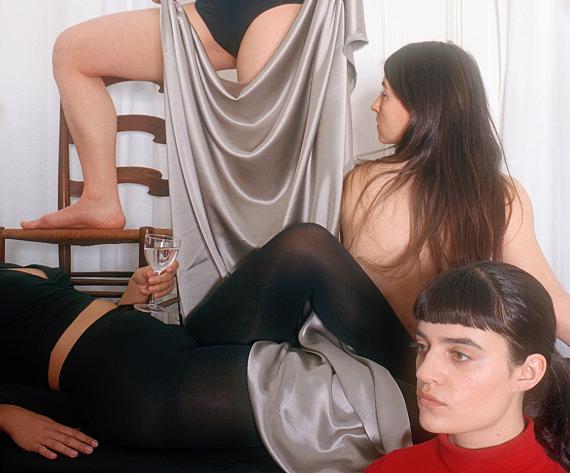
Tableau Vivant, 2020
C-print
60 x 73,5 cm
3 + 2 AP
© Jenna Westra
Courtesy: SCHWARZ CONTEMPORARY
Jenna Westra
"Mellow Drama"
Ausstellung: 25. Juni bis 31. Juli 2021
Eröffnung: Donnerstag, 24. Juni, 16 - 20 Uhr
Jenna Westras Fotografien fangen eine aufgeführte Intimität ein – eine Ungezwungenheit der Bewegung, die es im echten Leben gibt, wird im Atelier reproduziert. Bei Intertwined Women bin ich unsicher, wo ein Körper endet und der andere beginnt. Das Gefühl einer auf meinem Oberschenkel ruhenden Hand wird durch das Bild übertragen – die Geste ist so bekannt, dass ich mir das genaue Gewicht der auf mir liegenden Hand vorstellen kann. Ist es meine eigene Hand? Oder die einer Freundin? Der Unterschied ist unwesentlich, da die beiden Formen der Berührung sich so sehr ähneln.
Das Überlappen von Körpern auf Westras Fotografien veranschaulicht das oft ignorierte somatische Element der Freundschaft unter Frauen. Die physische Nähe ist ein platonisches Echo der Erotik sexueller Beziehungen. Eine Intimität, bei der eine andere zu berühren wie sich selbst zu berühren ist, und umgekehrt. Körper fließen ineinander, Grenzen lösen sich auf, Eigenschaften verdoppeln sich.
Männliche Filmemacher – insbesondere Hitchcock und Bergman – haben dieses Verschmelzen voller Angst dargestellt. Das Verwischen der Grenzen zwischen zwei Frauen (oft sowohl physisch als auch visuell) wird als ein Zeichen von Wahnsinn
gezeigt. Eine Frau muss gewaltsam die Bande zur anderen kappen, um wieder sie selbst zu werden. Die Realität ist nuancierter, wo das Spiegeln und Verschmelzen von Körpern sowohl intensiv als auch liebevoll ist. Westra fängt dieses Spektrum der Berührung ein.
Portraitfotografie fängt einen Moment der Aufführung ein. Wie Peggy Phelan schreibt: "Unsicher darüber, wie dieser Körper aussieht oder wie materiell er ist, führen wir ein Bild auf, indem wir das imitieren, von dem wir denken, dass wir so
aussehen." Mit anderen Worten filtern Fotografien das Bild, das man von sich selbsthat, durch den Blick des Anderen – in diesem Fall zwischen den Models und Westra.
Der kollaborative Prozess, den Westra steuert, indem sie die Choreografie und Posen bestimmt, etabliert eine fast psychologische Übertragung. Die Wiederholung in Westras Fotografien zirkuliert zwischen dem Ich und dem Anderen. Westra fängt die verschiedenen Persönlichkeiten einer einzigen Person ein, manchmal in einem Bild. Two Vivians (Print) ist ein gutes Beispiel. Auf der Fotografie steht eine Frau vor einem Bild von sich. Auf dem Hintergrundbild betrachtet sie ein Glas Wasser. Im Vordergrund starrt sie herausfordernd die Fotografie an der Wand an. Das Ergebnis sind stark unterschiedliche Bilder derselben Person. Stünde die echte Vivian vor Two Vivians (Print), würde sie noch mal anders aussehen. Würde sie wieder vor besagter Fotografie fotografiert: wieder anders.
"Fotografen entwickeln das Bild, wenn sie den Auslöser berühren: Modelle performenso, wie sie denken, das das Bild aussieht", schreibt Phelan. Westra treibt dieses Konzept weiter voran, indem sie ihre Subjekte verdoppelt und es ihnen so
ermöglicht, sich als sowohl sie selbst als auch durch Westras Blick zu sehen und gesehen zu werden. "Das performative Wesen der Portraitfotografie verkompliziert den traditionellen Anspruch der Kamera, etwas authentisch 'Echtes' zu
reproduzieren", schreibt Phelan.
Das Studio-Setting von Westras Fotografien etabliert die Bilder bereits als nicht echt, die sorgfältige Choreografie, zusammen mit der Performance der Models, weist die Fotografien als Fiktionen aus. Wo situieren die Betrachter*innen sich in diesen Bildern? Sehen sie sich selbst oder das Andere? Legen sie ihren eigenen Blick über die Fotografie? Oder diktiert Westras Blick die Art des Sehens? Dass Westra und auch die Kamera selbst im Self Portrait with Melon, Darkroom Curtains erscheinen, ist bemerkenswert. Indem sie die vierte Wand durchbricht, betont Westra noch einmal ihre Rolle als die des einzigen Blicks der Bilder. Die Öffnung des Vorhangs erinnert mich an gespreizte Beine – was auf
jenen Faden der Erotik verweist, die die Arbeit durchsticht. Eine ähnliche Form findet sich in Braid, Demi-Plié, wo das visuelle Alphabet der Körper artikuliert wird, das sich durch die Ausstellung zieht. Eine Melone sitzt auf Westras gekreuzten und aufgestellten Beinen, ein Totem der Formen. Als Metapher gelesen, erinnert die perfekt runde Frucht an eine runde Linse eines Objektivs wie auch an eine Iris (das Auge und das Ich beide im Bild präsent). Während Westra für sich selbst performt, wird eine ganze Ausstellung in ein einziges Bild eingefaltet.
Text: Tatum Dooley, Translation: Wilhelm von Werthern
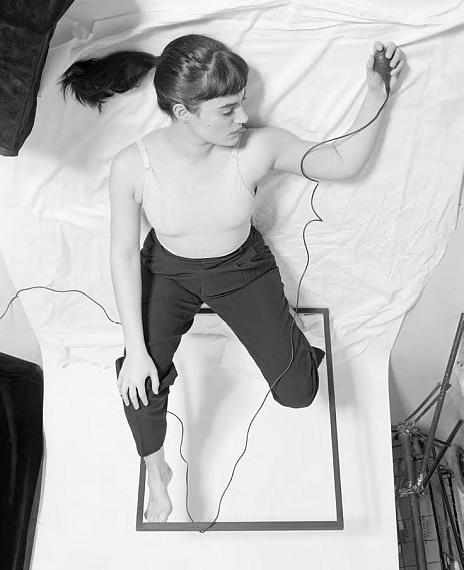
Vivian with Shutter Release and Frame (inverted), 2020
Silver gelatin print
61 x 50 cm
3 + 2 AP
© Jenna Westra
Courtesy: SCHWARZ CONTEMPORARY
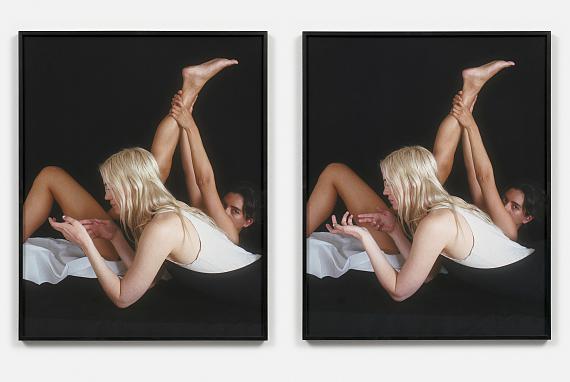
Triangular Gaze 1+2, 2021
c-print
76 x 61 cm
3 + 2 AP
© Jenna Westra
Courtesy: SCHWARZ CONTEMPORARY